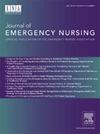Investigation of Emergency Nurses in Detecting Foreign Bodies in Soft Tissues With Ultrasonography: A Manikin Study
IF 2.3
4区 医学
Q2 EMERGENCY MEDICINE
引用次数: 0
Abstract
Introduction
Foreign bodies in the soft tissue are a critical clinical condition after traumatic injuries. Physical examination is unreliable, and plain radiographs cannot detect radiolucent foreign bodies. In our study, we investigated emergency nurses’ foreign body detecting skills on soft tissue with focused ultrasonography.
Methods
This study was planned prospectively with 8 emergency nurses. Emergency nurses underwent 3 hours of theoretical and practical training in imaging foreign bodies with ultrasonography. Chicken thighs were used as foreign body manikins. Metal, wood, and glass materials were used as foreign bodies. After the investigations of manikins, emergency nurses stated whether or not foreign bodies were detected.
Results
Eight emergency nurses performed 384 sonographic examinations. Median postgraduate years of emergency nurses were 6.5 years (interquartile range, 4.5; minimum, 3; maximum, 11). This study showed that foreign body detection with ultrasonography had 87.5% (95% CI, 81.5-92.1) sensitivity, 77.4% (95% CI, 70.3-83.5) specificity, 79.5% (95% CI, 74.1-83.7) positive predictive value, 86.1% (95% CI, 80.5-90.3) negative predictive value, and 82.4% (95% CI, 78-86.4) accuracy.
Discussion
Ultrasonography has good sensitivity and moderate specificity for detecting foreign bodies in the soft tissue by emergency nurses.
急诊护士超声检查软组织异物的临床研究。
软组织异物是外伤性损伤后的重要临床症状。体格检查是不可靠的,x线平片不能检测到透光的异物。在本研究中,我们调查了急诊护士用聚焦超声检查软组织异物的技巧。方法:对8名急诊护士进行前瞻性研究。急诊护士在超声成像异物方面接受了3小时的理论和实践培训。鸡腿被用作异物模型。金属、木材和玻璃材料被用作异物。在对人体模型进行调查后,急诊护士说明是否检测到异物。结果:8名急诊护士进行了384次超声检查。急诊护士研究生学龄中位数为6.5年(四分位数差为4.5;至少,3;最大,11)。本研究显示,超声检查异物的敏感性为87.5% (95% CI, 81.5 ~ 92.1),特异性为77.4% (95% CI, 70.3 ~ 83.5),阳性预测值为79.5% (95% CI, 74.1 ~ 83.7),阴性预测值为86.1% (95% CI, 80.5 ~ 90.3),准确率为82.4% (95% CI, 78 ~ 86.4)。讨论:超声对急诊护士检测软组织异物具有良好的敏感性和中等的特异性。
本文章由计算机程序翻译,如有差异,请以英文原文为准。
求助全文
约1分钟内获得全文
求助全文
来源期刊
CiteScore
3.10
自引率
11.80%
发文量
132
审稿时长
46 days
期刊介绍:
The Journal of Emergency Nursing, the official journal of the Emergency Nurses Association (ENA), is committed to the dissemination of high quality, peer-reviewed manuscripts relevant to all areas of emergency nursing practice across the lifespan. Journal content includes clinical topics, integrative or systematic literature reviews, research, and practice improvement initiatives that provide emergency nurses globally with implications for translation of new knowledge into practice.
The Journal also includes focused sections such as case studies, pharmacology/toxicology, injury prevention, trauma, triage, quality and safety, pediatrics and geriatrics.
The Journal aims to mirror the goal of ENA to promote: community, governance and leadership, knowledge, quality and safety, and advocacy.

 求助内容:
求助内容: 应助结果提醒方式:
应助结果提醒方式:


